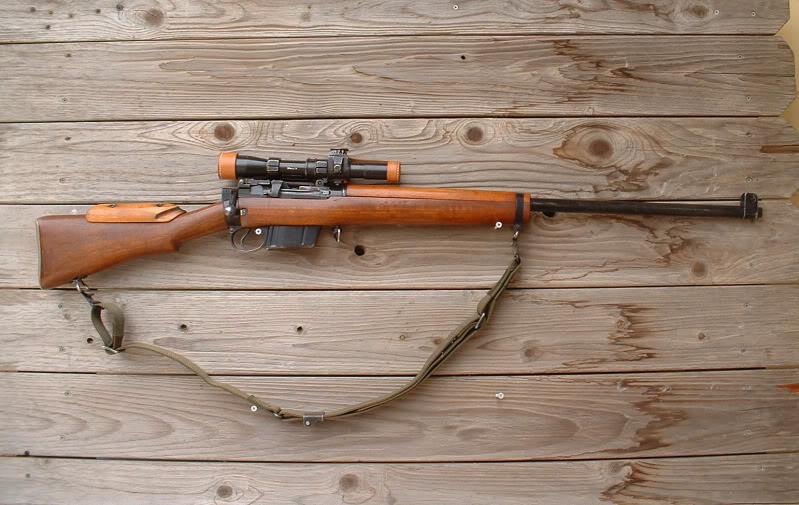-
Legacy Member

Nice find! Welcome to the club. We should get together somewhere and have an L42 shoot. 
-
-
12-21-2010 11:58 PM
# ADS
Friends and Sponsors

-
Legacy Member



Originally Posted by
limpetmine

Nice find!
Thank you for the nice find!! 
-
-
-
Legacy Member

Thanks Peter for your response.
So that I can determine if the rifling on my 74 dated rifle is Enfield or chordal or indeed something else can you please advise the number of lands, twists and anything else you can including production dates, about the different types of rifling. Hopefully we can then answer more fully the question "Was chordal rifling produced and used on 74 L42's" . Attaching some more photos of the bore which may help.
Happy Christmas
Graeme
Attachment 18334 - Attachment 18332 - Attachment 18333
Last edited by Badger; 12-22-2010 at 04:38 PM.
Reason: Edited post to fix attachments. Use ATTACH button instead of INSERT INLINE for better appearance ....
-
-
Legacy Member

Cool tools, enjoy.

MJ, don't take this personally, but that's crap.
muffett.2008

-
-
Legacy Member



Originally Posted by
Bearclaw

did it come with it's case.
Rifle and scope only, I will have to work on getting the rest at a later date.
-
-
Good question Broadarrow but maybe the question regarding the rifling form should be opened up to all. I'll report back with the rifling of all our L39's and 42's. In the meantime, so far as I remember, very few L42/39 barrels were changed for actual barrel/gauge wear as such (The Sniper Division rifles were the exception of course.........) but inability to zero according to the spec, inaccuracy and the biggest failure, hard extraction. It was impossible to actually see a bulge in the chamber, but bulged they were (as Ensci reports elsewhere). We called them stretched chambers although they weren't really 'stretched' of course and discussions regularly took place regarding the problem. If it were stretched, it'd increase the critical CHS. From that, it necessarily follows that a rifle could have a later barrel or on a much lesser scale, an earlier barrel on a later rifle if such a barrel came through the Ordnance system.
Towards the end of their lives, although barrels were available through the Ordnance system, nobody replaced barrels, the rifles were simply written off and replaced. And with that, the art died a natural death
As I have said before, sometimes you'd get a barrel that was highly suspect...., worn lead, with rifling almost flat but the sniper would confirm the Armourers accuracy range test that it was as accurate as anything he'd ever had. So if it CHS'd and accepted the free run of the .297" Gauge, that was good enough. Others, with gleaming barrels and crisp sharp or rounded rifling would shoot like a pig, even after all of the usual repairs. They'd get the chop of course and the write off paperwork would be attached to the accuracy pattern target would be returned to Ordnance where a replacement would be issued.
-
Thank You to Peter Laidler For This Useful Post:
-
It was impossible to actually see a bulge in the chamber, but bulged they were (as Ensci reports elsewhere). We called them stretched chambers although they weren't really 'stretched' of course and discussions regularly took place regarding the problem.
Was this something that would develop in a rifle or something that would be present from the start of a barrels/rifles life?
-
-
I think that it developed in time TBone. Because Armourers at the big Command and Base workshops would only deal with Armourers at the lower level units and because you all knew each other, with individual weapons, you'd be told what the problem was because the sniper had told the unit Armourers. He'd feel it getting worse until, in several cases, when the case was still hot, you couldn't even lift the bolt handle. I remember taking such a rifle up to the range and shooting a couple of rounds while Danny, David, Roger, me and a couple of the others all pondered the problem.
-
The Following 2 Members Say Thank You to Peter Laidler For This Useful Post:
-
What were some of the theories as to the cause?
-
-
Ensci will give a more exact scientific answer but we suspected that overtightened breeching up was the problem. Any 'bulge' was caused by the inability of the material to resume its natural state. The MAG (the Maintenance Advisory Groups) who worked with the RSAF took some chamber castings in alloy but even then they were tight to remove! I had/still have somewhere one of the bulged chamber sections that I machined down to make a simple calibration cup for the various 7.62mm CHS gauges
-















 PM
PM
















